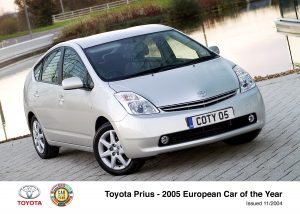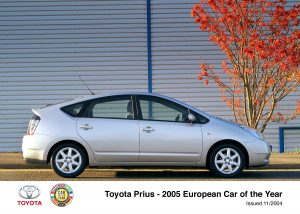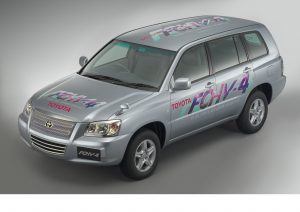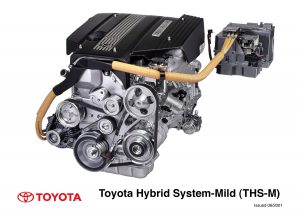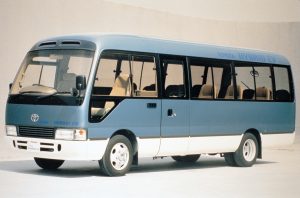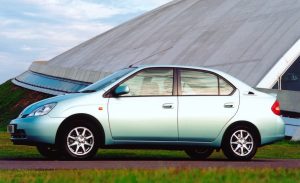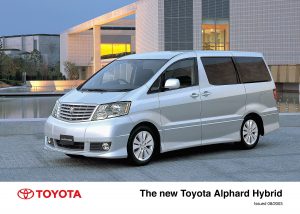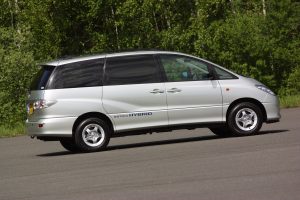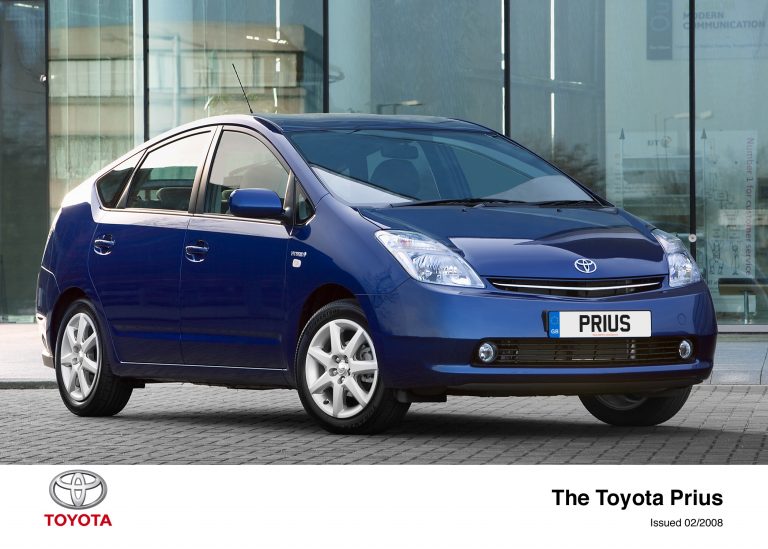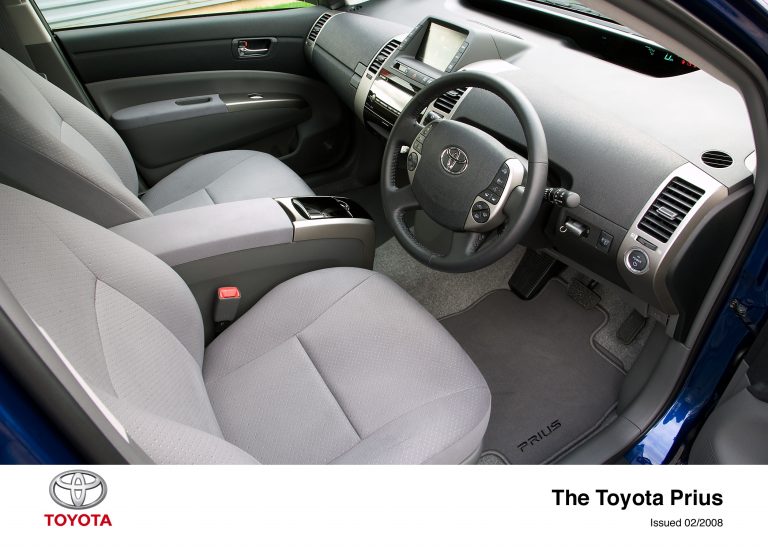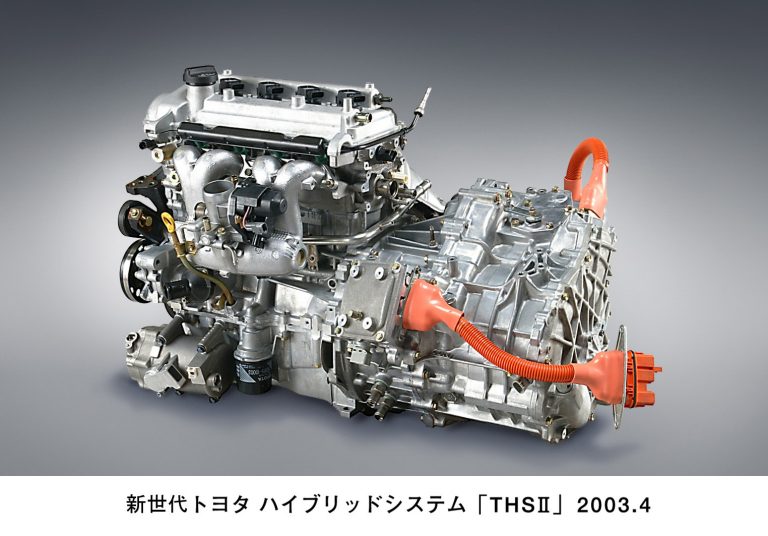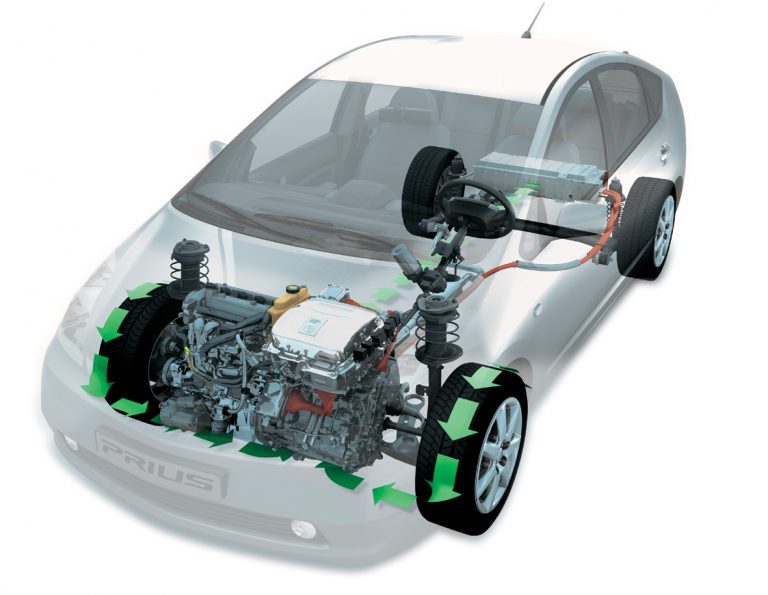Toyota Prius Wins 2005 European Car Of The Year
The Toyota Prius has been voted 2005 Car of the Year by the 58 members of the European Car of the Year Jury. After two rounds of voting, the car was chosen from a list of seven finalists and declared clear winner after gathering 406 points.
Tadashi Arashima, President and CEO of Toyota Motor Marketing Europe said: “We are absolutely delighted to receive the 2005 Car of the Year award for Prius. We believe that hybrid technology, in particular as implemented in the Prius with our revolutionary Hybrid Synergy Drive® system, represents a big step forward in reducing the environmental impact of automobiles, while at the same time enhancing driving performance. We are proud and honoured that Prius has been endorsed so strongly by the prestigious group of journalists who make up the Car of the Year jury. This is a major milestone in the acceptance of the hybrid powertrain and the recognition of its potential to become a mainstream technology. It is also a great encouragement to us in our work on developing more environmentally friendly vehicles.”
Prius, the world’s first mass produced hybrid vehicle, is propelled by the combination of an electric motor and a petrol engine. This unique system, called Toyota Hybrid Synergy Drive®, will spearhead the development of new environmentally friendly powertrains and is part of Toyota’s effort to create the ultimate eco car.
Following its introduction in early 2004, Prius sales in Europe are expected to reach 8,500 units this year. Next year, the sales target has been set at 15,000 units for Europe, whilst an increase in production capacity will allow 180,000 cars to be sold worldwide.
Prius has been in strong demand in the UK with sales reaching almost 1400 units this year.
Note to editors:
The European Car of the Year award is voted by 58 professional motoring journalists from 22 European countries and is open to all new cars available in the European market in the year before the award. From all the new models eligible, seven cars are selected for the final shortlist. The final award is decided by vote, with each judge allocating 25 points between a minimum of five cars on the shortlist.
History of Hybrid Technology
NEW PRIUS IS THE RESULT OF FOUR DECADES OF HYBRID EXPERIENCE
- Toyota’s research into hybrid power began almost 40 years ago
- 1977 Sports 800 hybrid inspiration for Toyota Hybrid Synergy Drive® philosophy
- 1997 marks the launch of the world’s first hybrid bus (Coaster HV) and car (Prius)
- In 2000 an improved version of Prius launched in Europe and the USA
- 2001 brings first 4WD hybrid, the Estima Hybrid
- Hybrid introduces a host of technologies, including world’s first brake-by-wire system
- First mild hybrid application in 2001 (Crown Mild Hybrid with THS-M)
- World’s first production fuel cell car (Toyota FCHV) uses hybrid power as well
- Alphard HV launched in 2003, Toyota now offers six different hybrid production models
- The future starts now, with the new Toyota Prius
THE ROOTS OF HYBRID TECHNOLOGY
Toyota might have hit the headlines when it launched the original Prius to world acclaim in 1997, but its history of developing environmentally-friendly hybrid vehicles stretches back nearly 40 years to 1965 when it started investigating the feasibility of using gas turbines to power an electric drive system for cars.
In 1969 Toyota developed a bus equipped with this system, but with a two-shaft engine. Six years later the same technology was applied to a passenger car with the display of the gas turbine/electric Toyota Century hybrid, a version of Toyota’s flagship model in Japan.
In 1977, Toyota displayed its future thinking in the Toyota Sports 800 gas turbine hybrid. The application of a prototype hybrid system in this purpose-built sports car embodied a concept that Toyota engineers already had in their minds – performance with respect for the environment. This is exactly the same philosophy that is being followed today with Toyota’s latest Hybrid Synergy Drive®.
TOYOTA’S COMMITMENT TO THE ENVIRONMENT
Now the world’s third largest producer of vehicles and its best-selling brand, Toyota passionately believes it has a responsibility to protect the environment, while ensuring the daily transport needs of everyone and providing efficient, cost-effective transport for future generations. This is not a trendy ‘green’ stance but a strategic element to Toyota’s long-term plans.
Toyota has a well-founded history of developing practical, intelligent solutions to achieve the long-term goal of reducing emissions and fuel consumption, whatever the powertrain. Toyota is working on a wide spectrum of advanced combustion technologies such as Variable Valve Timing-intelligent (VVT-i) petrol engines and high pressure, common-rail diesel engines.
Since that journey began nearly four decades ago with the turbine car, Toyota has achieved a number of significant milestones.
In 1997, Toyota unveiled its Coaster HV, a small bus that was the world’s first hybrid vehicle, powered both by an electric motor and a petrol engine. Designed for transportation and sightseeing in areas such as theme parks and resort facilities, the Coaster combines an electric motor with a 1.5-litre petrol engine, has far cleaner emissions, and is much quieter under acceleration.
In the same year, the world-beating Prius was introduced, the first production hybrid passenger car. The Prius delivered ultra-low emissions in urban conditions, an unlimited driving range and a regenerative braking system that recycled surplus energy back into the car’s storage batteries. All this was made possible thanks to the THS (Toyota Hybrid System).
The Prius was an immediate success and, among its more unusual accolades, it became the first hybrid car to finish an FIA sanctioned rally, 14th in the gruelling, three-week, 5,000 mile Midnight Sun to Red Sea Rally of 2002.
In the space of three years the Prius gathered no fewer than 20 prestigious awards from around the world, including the 1997 Japanese Car Of The Year title and the 1999 Global 500 Award for Environmental Commitment from the United Nations.
With outstanding fuel economy – 55.4mpg on the EC combined cycle – and carbon dioxide emissions of 120g/km, the Prius could still cruise at 100mph and reach 62mph in 13.4 seconds.
While Prius was gathering all the awards, Toyota engineers were not resting on their laurels. They were busy developing both existing petrol and diesel engines in a never-ending quest to reduce their environmental impact.
THE NEXT STEPS IN HYBRID TECHNOLOGY
In 2000 Prius benefited from a host of improvements, giving it better performance and still lower emissions. Styling and equipment enhancements were introduced and Prius was launched in Europe and the USA, starting the “hybrid revolution” in the world’s largest car markets.
In June 2001 Toyota brought hybrid powertrains to the fast-growing four-wheel drive market with the introduction of the Estima Hybrid in Japan. The car launched a revolutionary body control system which delivers levels of stability and agility that have never before been seen in an MPV. The system uses world-first ‘by-wire’ braking which works in close coordination with the vehicle’s ABS, EBD, Brake Assist, Traction Control (TRC) and Vehicle Stability Control (VSC).
In addition, the Estima’s hybrid power plant can generate up to 1500 watts of auxiliary 100-volt AC, making it ideal for use as an emergency vehicle or mobile office. Telematics and ITS (Intelligent Transport System) functions add further safety, convenience and entertainment benefits.
The Estima Hybrid uses a CVT in a compact front transaxle to transmit main motor energy, together with a rear transaxle that combines a second motor and differential gear in a single unit, creating a lightweight, compact structure that enables four-wheel drive without a driveshaft. The Estima Hybrid can travel up to 625 miles on one tank of fuel, achieving twice the fuel efficiency of Japan’s 2010 standards, and one quarter of the HC and NOx levels stipulated in Japan’s latest regulations.
The Estima Hybrid was followed by a hybrid version of Toyota’s Crown luxury saloon powered by a mild-hybrid (mybrid) that improves fuel efficiency by about 15 per cent.
The Crown retains its three-litre, direct injection engine producing 203bhp and 294Nm of torque, but this is augmented by a three-kilowatt electric motor/generator which supplies an additional 56Nm of torque between zero and 300rpm.
The THS-M (Toyota Hybrid System-Mild) comprises a small motor-generator connected to a high-efficiency engine by an electrical accessories-powering belt, a compact 36V secondary battery for appropriate power supply to the motor and a control unit. The system’s 36V battery (in the world’s first in-car 42V power system) is able to meet both the large electrical power demands of the hybrid system and the increasing electrical load of modern cars. The higher voltage and resulting smaller current possible in a 36V battery system allow the wire harnesses to be much thinner than those in standard 12V systems, contributing to overall weight reduction and less demand on materials resources.
In 2001, Toyota introduced the FCHV-4, its latest experimental fuel cell hybrid vehicle.
FCHV-4 incorporates a fuel cell and a battery to ensure a constant supply of electrical power. To manage this hybrid combination of power sources, Toyota has used the same computerised control technologies as deployed in the THS. An improved version of the FCHV-4 is now being marketed with the name FCHV.
Toyota started limited marketing of the Toyota FCHV sport utility vehicle in Japan and the United States around the end of 2002, much earlier than originally planned. Thus far, 20 units have reached the road in the US and Japan. Powered by pure compressed hydrogen gas, the FCHV is an SUV with a kick. Its Toyota FC stack puts out an impressive 90kW and 260Nm of torque — more than four times that of Toyota’s first fuel cell car in 1996, giving it a top speed of 97mph, and a cruising range of 187 miles.
This year Toyota introduced its second hybrid MPV to the Japanese market, the Alphard HV. The vehicle shares the same components with the Estima HV, which itself received a host of improvements for 2003. The arrival of the Alphard HV increased the number of Toyota hybrid models to six, three times as many as any other manufacturer has managed to put on the market.
2003 also brought the second generation Prius, equipped with many technical innovations that bring the future of motoring into the here and now.
ENDS

